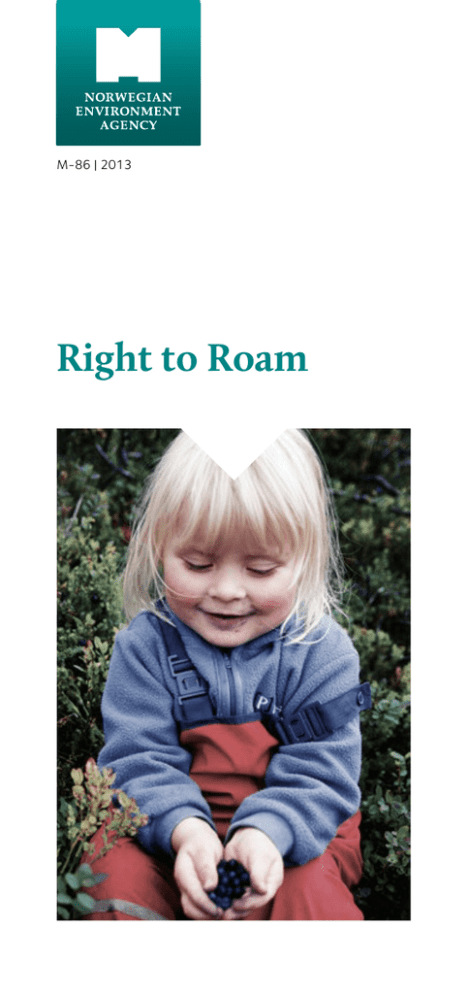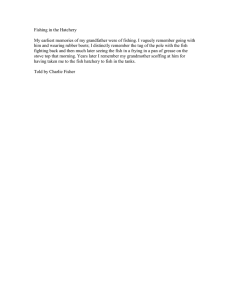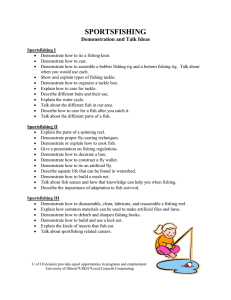Right to Roam - Miljødirektoratet
advertisement

M-86 | 2013 Right to Roam Hiking and Skiing Hiking and skiing are freely permitted in open countryside in summer and winter alike. You can follow hiking trails, private roads and groomed ski trails or strike out on your own. In the winter you are also allowed to cross frozen or snow-covered fields and meadows. You may use paths and roads across fenced land year-round, so long as you keep your distance from farmyards, houses and cabins. Photo: Bård Bredesen, Naturarkivet.no Right to Roam Outdoor recreation is an important part of our cultural heritage in Norway. Since ancient times, we have had the right to roam freely in forests and open country, along rivers, on lakes, among the skerries, and in the mountains – irrespective of who owns the land. We are allowed to harvest nature’s bounty – which means not only saltwater fish, berries, mushrooms and wildflowers, but also our sensory impressions of the whole outdoor experience. The main principles of the right to roam are legally enshrined in the Outdoor Recreation Act of 1957. The right to roam applies to open countryside, where the following activities are permitted: • Free movement on foot and on skis • Resting and overnight camping • Riding and cycling on trails and roads • Swimming, canoeing, rowing and sailing • Picking berries, mushrooms and wildflowers • Fishing without a licence for saltwater species 2 In open country, you can stop and rest where you wish, but please stay clear of inhabited houses and cabins, and be considerate of other visitors. You may light a fire in open country, but not in or near woodland between April 15 and September 15. Don’t damage trees when gathering wood for your fire – use old, dry branches and twigs. If you build a bonfire on the shore, don’t place it directly on rock, as this may cause the rock to split. When you are in open country, remember: • not to take shortcuts across fenced land, farmyards or other private property • to comply with bylaws governing recreational areas and nature reserves, in order to avoid erosion and protect vulnerable wildlife and plant habitats • not to disturb animals and birds, particularly during breeding and nesting season • not to damage plants, especially rare species • to use established rest areas and firepits, and to be especially careful around fire • to respect other people’s need for space and peace and quiet • not to pitch a tent close to an inhabited house or cabin (no closer than 150 m/500 ft unless local bylaws provide otherwise) • not to disturb livestock • to respect the interests of people who live and work in the countryside 3 • not to pitch a tent close to an inhabited house or cabin (no closer than 150 m/500 ft unless local bylaws provide otherwise) • to respect the interests of people who live and work in the countryside Photo: Bente Rønning/Miljødirektoratet Cycling Cycling is permitted on private roads and trails in the lowlands, and anywhere in the mountains. You can ride your bike wherever there is a right of public access. You may also cycle across fenced land on private roads and established paths leading to open country, although organized groups and commercial users are not allowed to do so. Just be sure that the road, path or terrain you are using is suitable for cycle traffic. Some greenbelt land, recreational areas and nature reserves may have special rules or even a complete ban on cycling. Check whether there are designated cycle routes and a cycling map of the area. Horseback Riding Riding is permitted on private roads and trails in the ­lowlands, and anywhere in the mountains. You can ride your horse wherever there is a right of public access. You may also ride across fenced land on private roads and established paths leading to open country, although organized groups and commercial users are not allowed to do so. Just be sure that the road, path or terrain you are using is suitable for horse traffic. Some greenbelt land, recreational areas and nature reserves may have special rules or even a complete ban on riding. Check whether there are designated bridle paths in the area. In the case of large-scale organized use of open country by riding schools and similar establishments you are advised to seek an agreement with the landowner. Note that landowners may refuse to allow horse-drawn vehicles to use private roads. When cycling in open country, remember: • to avoid areas prone to erosion such as bogs and dry rock • that not all trails are suitable for bikes – choose those that are • to use trails that are less popular with hikers, in order to avoid arguments • to make sure you don’t disturb wildlife or livestock • to slow down when approaching and passing hikers • to use established rest areas and firepits, and to be especially careful around fire Photo: Sigve Reiso, Naturarkivet.no 4 5 When riding in open country, remember: • to avoid areas prone to erosion such as bogs and dry rock • that not all trails are suitable for horses – use ­suitable trails and bridle paths • to slow down to a walk when approaching and passing hikers • not to ride on ski trails and in ski tracks on forest roads in the winter – make your own tracks instead • to be courteous and considerate toward hikers and cyclists, so that no-one is alarmed or injured • not to disturb animals and birds, particularly during ­breeding and nesting season • not to bathe your horse at places where people swim or sources of drinking water • to respect the interests of people who live and work in the countryside Photo: Kim Abel, Naturarkivet.no In open country in the lowlands, you can pitch a tent and camp overnight for up to 48 hours in one location without prior permission from the landowner. In the mountains, and in remote, sparsely populated areas, you may camp for longer than 48 hours. Unless local bylaws provide otherwise, you must never pitch your tent within 150 metres (500 feet) of an inhabited house or cabin. Always take care not to damage young trees. Remember, you must not camp on fenced land without the landowner’s permission. You may light a fire in open country, but not in or near woodland between April 15 and September 15. Don’t damage trees when gathering wood for your fire – use old, dry branches and twigs. If you build a bonfire on the shore, don’t place it directly on rock, as this may cause the rock to split. When camping in open country, remember: • to comply with bylaws governing camping in ­recreational areas and nature reserves, in order to avoid erosion and protect vulnerable wildlife and plant habitats • to use established rest areas and campsites where possible • to pitch your tent where you will not disturb animals and birds, particularly during breeding and nesting season • not to leave permanent scars on vegetation or terrain • to respect other campers’ need for space and peace and quiet • to use established firepits, and to be especially careful around fire • not to disturb livestock • to respect the interests of people who live and work in the countryside 6 7 Camping You are allowed to pull any kind of vessel ashore in open country for a short time. If you wish to moor at a private dock or jetty, you must seek permission from the owner or user. You can use mooring rings, bolts and similar equipment in open country for short periods so long as this does not seriously inconvenience the owner or user. Photo: Kim Abel, Naturarkivet.no Canoeing, Rowing and Sailing You are free to travel the sea, lakes and rivers by canoe, rowboat or sailboat, and except for a few canals and locks it costs nothing. You can also use motorboats on the sea, stretches of river (provided they are part of a navigable river) and lakes larger than 2 square kilometres (0.75 square miles). However, there may be local bylaws r­ estricting the use of motorboats on lakes and rivers. 8 When boating in open country, remember: • to find out all you can about the river or lake, safety issues and local bylaws before setting out • to wear a lifejacket at all times • to dry your boat, oars/paddle and boots before moving to another river or lake, in order not to spread disease • to disinfect any fishing gear, boat, oars/paddle and boots used in rivers or lakes carrying infectious fish diseases • to be considerate of fishermen and other users of lakes and rivers • not to interfere with nets or other fishing gear • to travel quietly and not make unnecessary noise • not to disturb animals and birds, particularly during breeding and nesting season • to use established rest areas and firepits, where ­available, and to be especially careful around fire • not to pitch a tent close to an inhabited house or cabin (no closer than 150 m/500 ft unless local bylaws provide otherwise) • to respect the interests of people who live and work in the countryside 9 Fishing You can fish with rod and line for saltwater species year-round, from a boat or from the shore. You may also fish in the sea free of charge for salmon, sea trout and sea char year-round, using a rod from the shore, but local bylaws may include exceptions to this general rule. Sea fishing is not permitted within 100 metres (325 ft) of a river mouth during the conservation season. To fish for salmon, sea trout and sea char in rivers and lakes, you must purchase a fishing licence from the government and usually also a fishing permit from the landowner. If you are under 16, you can fish free of charge for inland species between January 1 and August 20, except where there are salmon, sea trout and sea char. Under-16s are not allowed to catch crayfish or to fish in man-made fish dams. Some lakes and rivers may be exempt from these rules, in which case signs should be displayed stating that free fishing does not apply. Before starting to fish, you must familiarize yourself with the fishing regulations. When fishing in open country, remember: • to carry your fishing licence and permit, or ID to prove you are under 16 • not to use live fish as bait • not to transfer live fish to another river or lake • to dry your tackle, boots and waders before moving to another river or lake, in order not to transfer live ­organisms and spread disease • to disinfect any fishing gear used in rivers or lakes ­carrying infectious fish diseases • to clean and wash fish in the water they were caught in • to use established rest areas and firepits • not to disturb other fishermen or river/lake users • to respect the interests of people who live and work in the countryside, both while fishing and while travelling to and from your fishing spot 10 Photo: Bård Bredesen, Naturarkivet.no Don’t transfer species and spread fish diseases! 11 Picking Berries, Mushrooms and Plants Grab your basket or pail so you can pick berries, ­mushrooms, wildflowers and wild herb roots in open country and take them home with you. Please note that special rules apply to picking cloudberries in the counties of Nordland, Troms and Finnmark, where landowners or users can prohibit picking. Any such prohibition must be notified through clear signposting, a newspaper announcement or equivalent means. Unless expressly prohibited in this way, cloudberries can be picked freely. In these counties owners can issue prohibitions in relation to cloudberry fields. These are areas of cloudberry plants, regardless of their location, which are so large and productive that they are of significant financial value to the landowner. Even if a cloudberry field is covered by a prohibition, you are still always allowed to pick cloudberries that you eat on the spot. On the Finnmark Estate everyone may pick cloudberries for their own personal use, but only residents of Finnmark can pick them for sale. Be careful when ­collecting other natural products such as rocks, minerals, peat, moss and lichen. Ask the landowner’s permission before taking any holly, burls, roots or bark. When picking in open country, remember: • to make sure you know the conservation rules beforehand if you are visiting a nature reserve or conservation area (picking wildflowers, mushrooms, tree fungi and lichen may be prohibited in some areas) • to learn to recognize protected and endangered plant species, in order not to pick them 12 Photo: Kim Abel, Naturarkivet.no • not to remove roots, bark or burls from living trees without the landowner’s permission • not to disturb wildlife or livestock • not to pick berries close to a farm or an inhabited house • to be considerate of other pickers and countryside users • to respect the interests of people who live and work in the countryside 13 General Information on the Right to Roam To fish in inland waters, you need a fishing permit from the landowner. If you are under 16, you can fish free of charge between January 1 and August 20, except where there are salmon, sea trout and sea char. To hunt, you need the permission of the landowner, who owns the hunting rights. You also need to pass the hunter accreditation exam and purchase a hunting licence. Uncultivated land or open country includes most of ­Norway’s lakes, shores, bogs, forests and mountains and is usually not fenced off. Small uncultivated areas within cultivated land are not regarded as open country. Cultivated or built-up land: fields, meadows, pastures, gardens, courtyards, building plots and industrial sites. You do have access to some cultivated land, such as fields and meadows, between October 15 and April 30 when the ground is frozen or covered in snow. Please note that cultivated land need not actually be fenced off. Always close gates and respect livestock, whether you are on cultivated or on uncultivated land. Dogs must be kept on a leash between April 1 and August 20. Be careful around fire – you must not light a fire in or near woodland between April 15 and September 15. Find out about any local bylaws regarding dog leashing and bonfires, which are often stricter than the national regulations. Make sure you tidy up before leaving your picnic spot or campsite. Take any litter away with you, leaving nothing behind. 14 Photo: Kim Abel, Naturarkivet.no More information: www.miljodirektoratet.no www.frifo.no 15 Norwegian Environment Agency Telephone: +47 73 58 05 00 | Fax: +47 73 58 05 01 E-mail: post@miljodir.no Internet: www.environmentagency.no Postal address: P.O. Box 5672 Sluppen, N-7485 Trondheim Visiting address Trondheim: Brattørkaia 15, 7010 Trondheim Visiting address Oslo: Grensesvingen 7, 0661 Oslo The Norwegian Environment Agency is working for a clean and rich environment. Our primary tasks are to reduce greenhouse gas emissions, manage Norwegian nature, and prevent pollution. We are a government agency under the Ministry of Climate and Environment and have 700 employees at our two offices in Trondheim and Oslo and at the Norwegian Nature Inspectorate’s more than sixty local offices. We implement and provide advice on the development of climate and environmental policy. We are professionally independent. This means that we take independent decisions in individual cases. Utforming: Guri Jermstad. Trykk: Skipnes Our principal functions include monitoring the state of the environment, conveying environment-related information, exercising authority, overseeing and guiding regional and municipal authorities, providing expert advice, and assisting in international environmental work.



